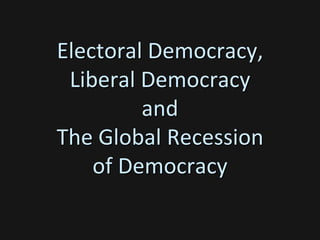The document discusses the themes of electoral democracy, liberal democracy, and the global recession of democracy, emphasizing the characteristics that define high-quality democracies, such as rule of law, civic participation, and responsiveness to citizen demands. It outlines the historical trends in democracy from 1974 to 2012, highlighting a peak in democratic states by 2005 followed by a decline, alongside concerns regarding the erosion of democratic principles worldwide. Factors contributing to the risks faced by democracy include weak institutions, executive abuse of power, and socio-economic challenges.













































